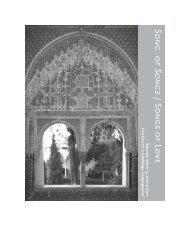BH1001, Guillaume Du Fay: Motets - Blue Heron
BH1001, Guillaume Du Fay: Motets - Blue Heron
BH1001, Guillaume Du Fay: Motets - Blue Heron
Create successful ePaper yourself
Turn your PDF publications into a flip-book with our unique Google optimized e-Paper software.
6<br />
quite garbled in its one source. According to<br />
Leofranc Holford-Strevens, “The text requires<br />
heroic emendation in several places to produce<br />
a semblance of sense; one might almost<br />
suppose that the poet, or scribe, had drunk all<br />
the wine that the teetotal Eugene had refused<br />
in his life.” 2 Whatever the virtues of the poetry,<br />
Ecclesie militantis is an extraordinary piece of<br />
music, with its two upper voices, two isorhythmic<br />
tenors (here doubled by slide trumpet and<br />
trombone) that quote short fragments of plainchant,<br />
and, for a fifth voice, a freely-composed<br />
contratenor that sings the same tune (“Bella<br />
canunt gentes”) three times, speeding up proportionally<br />
for the second time and returning<br />
to the original speed for the third iteration.<br />
Sanctus “Papale”<br />
Also possibly written for a specific occasion<br />
was the Sanctus “Papale.” David Fallows suggests<br />
that it may have been composed, along<br />
with the more famous work Nuper rosarum<br />
flores, for the consecration in 1436 of the<br />
Cathedral in Florence, Santa Maria del Fiore,<br />
and its newly-completed dome designed by<br />
Filippo Brunelleschi. Fallows further proposes<br />
that the Sanctus, troped with the poem Ave<br />
verum corpus, is intended for two antiphonal<br />
choirs, one consisting of choir boys and their<br />
master, a tenor, the other of men including<br />
falsettists. 3 We follow Fallows’ proposal here.<br />
The choirs join forces for the two statements of<br />
“Osanna,” dividing for a moment into six parts<br />
at the beginning of the first, a unique and striking<br />
coloristic effect.<br />
Hymns, faburden & fauxbourdon<br />
<strong>Du</strong> <strong>Fay</strong> apparently composed his cycle of<br />
hymns in 1434–35 in Savoy. In <strong>Du</strong> <strong>Fay</strong>’s hymns<br />
the unmeasured plainchant melody is set to a<br />
measured rhythm, ornamented, and sung by<br />
the discantus or highest voice. All were intended<br />
for performance in which plainchant alternated<br />
with polyphony verse by verse. <strong>Du</strong> <strong>Fay</strong> supplied<br />
two versions of the Marian hymn Ave maris stella.<br />
In the first the contratenor part is unnotated:<br />
the singer is to sing exactly what the discantus<br />
does, only transposed down a fourth, a texture<br />
known as fauxbourdon. <strong>Du</strong> <strong>Fay</strong>’s alternate setting<br />
uses the same discantus and tenor with a freelycomposed<br />
contratenor “sine faulx bourdon.” We<br />
sing verse 2 of the hymn in fauxbourdon, verse 6<br />
with the free contratenor part. For verse 4 we have<br />
chosen a setting ascribed in its unique, northern<br />
Italian source to “<strong>Du</strong>mstaple.” The chant melody<br />
followed in the piece is not the English Sarum<br />
variant, however; this would be a most unusual<br />
choice for <strong>Du</strong>nstable, and it seems quite possible<br />
that the piece is not by the English musician, but<br />
by some continental composer.<br />
The technique of fauxbourdon probably derived<br />
from improvisation, and it is related to the<br />
improvised English practice known as faburden,<br />
although the precise nature of the historical<br />
relationship is much debated. In faburden the



